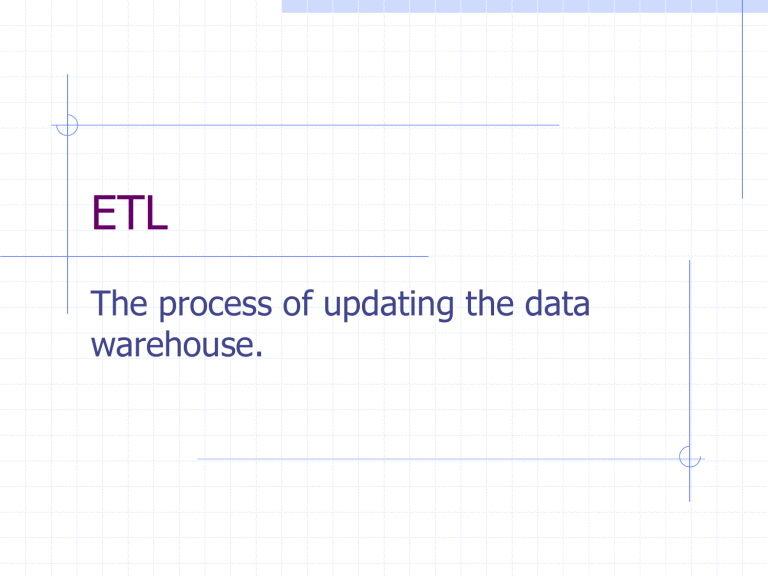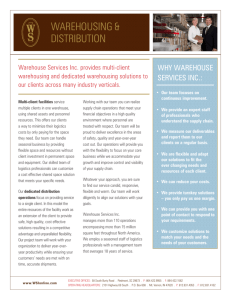The ETL Process

ETL
The process of updating the data warehouse.
Recent Developments in
Data Warehousing: A Tutorial
Hugh J. Watson
Terry College of Business
University of Georgia hwatson@terry.uga.edu
http://www.terry.uga.edu/~hwatson/dw_tutorial.ppt
Two Data Warehousing
Strategies
Enterprise-wide warehouse, top down, the Inmon methodology
Data mart, bottom up, the Kimball methodology
When properly executed, both result in an enterprise-wide data warehouse
The Data Mart Strategy
The most common approach
Begins with a single mart and architected marts are added over time for more subject areas
Relatively inexpensive and easy to implement
Can be used as a proof of concept for data warehousing
Can perpetuate the “silos of information” problem
Can postpone difficult decisions and activities
Requires an overall integration plan
The Enterprise-wide Strategy
A comprehensive warehouse is built initially
An initial dependent data mart is built using a subset of the data in the warehouse
Additional data marts are built using subsets of the data in the warehouse
Like all complex projects, it is expensive, time consuming, and prone to failure
When successful, it results in an integrated, scalable warehouse
Data Sources and Types
Primarily from legacy, operational systems
Almost exclusively numerical data at the present time
External data may be included, often purchased from third-party sources
Technology exists for storing unstructured data and expect this to become more important over time
Extraction, Transformation, and
Loading (ETL) Processes
The “plumbing” work of data warehousing
Data are moved from source to target data bases
A very costly, time consuming part of data warehousing
Recent Development:
More Frequent Updates
Updates can be done in bulk and trickle modes
Business requirements, such as trading partner access to a Web site, requires current data
For international firms, there is no good time to load the warehouse
Recent Development:
Clickstream Data
Results from clicks at web sites
A dialog manager handles user interactions.
An ODS (operational data store in the data staging area) helps to custom tailor the dialog
The clickstream data is filtered and parsed and sent to a data warehouse where it is analyzed
Software is available to analyze the clickstream data
Data Extraction
Often performed by COBOL routines
(not recommended because of high program maintenance and no automatically generated meta data)
Sometimes source data is copied to the target database using the replication capabilities of standard RDMS (not recommended because of “dirty data” in the source systems)
Increasing performed by specialized ETL software
Sample ETL Tools
Teradata Warehouse Builder from Teradata
DataStage from Ascential Software
SAS System from SAS Institute
Power Mart/Power Center from Informatica
Sagent Solution from Sagent Software
Hummingbird Genio Suite from Hummingbird
Communications
Reasons for “Dirty” Data
Dummy Values
Absence of Data
Multipurpose Fields
Cryptic Data
Contradicting Data
Inappropriate Use of Address Lines
Violation of Business Rules
Reused Primary Keys,
Non-Unique Identifiers
Data Integration Problems
Data Cleansing
Source systems contain “dirty data” that must be cleansed
ETL software contains rudimentary data cleansing capabilities
Specialized data cleansing software is often used. Important for performing name and address correction and householding functions
Leading data cleansing vendors include Vality
(Integrity), Harte-Hanks (Trillium), and
Firstlogic (i.d.Centric)
Steps in Data Cleansing
Parsing
Correcting
Standardizing
Matching
Consolidating
Parsing
Parsing locates and identifies individual data elements in the source files and then isolates these data elements in the target files.
Examples include parsing the first, middle, and last name; street number and street name; and city and state.
Correcting
Corrects parsed individual data components using sophisticated data algorithms and secondary data sources.
Example include replacing a vanity address and adding a zip code.
Standardizing
Standardizing applies conversion routines to transform data into its preferred (and consistent) format using both standard and custom business rules.
Examples include adding a pre name, replacing a nickname, and using a preferred street name.
Matching
Searching and matching records within and across the parsed, corrected and standardized data based on predefined business rules to eliminate duplications.
Examples include identifying similar names and addresses.
Consolidating
Analyzing and identifying relationships between matched records and consolidating/merging them into ONE representation.
Data Staging
Often used as an interim step between data extraction and later steps
Accumulates data from asynchronous sources using native interfaces, flat files, FTP sessions, or other processes
At a predefined cutoff time, data in the staging file is transformed and loaded to the warehouse
There is usually no end user access to the staging file
An operational data store may be used for data staging
Data Transformation
Transforms the data in accordance with the business rules and standards that have been established
Example include: format changes, deduplication, splitting up fields, replacement of codes, derived values, and aggregates
Data Loading
Data are physically moved to the data warehouse
The loading takes place within a “load window”
The trend is to near real time updates of the data warehouse as the warehouse is increasingly used for operational applications
Meta Data
Data about data
Needed by both information technology personnel and users
IT personnel need to know data sources and targets; database, table and column names; refresh schedules; data usage measures; etc.
Users need to know entity/attribute definitions; reports/query tools available; report distribution information; help desk contact information, etc.
Recent Development:
Meta Data Integration
A growing realization that meta data is critical to data warehousing success
Progress is being made on getting vendors to agree on standards and to incorporate the sharing of meta data among their tools
Vendors like Microsoft, Computer Associates, and Oracle have entered the meta data marketplace with significant product offerings








